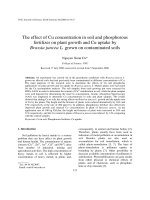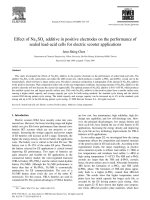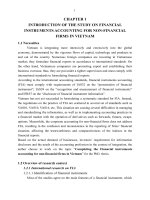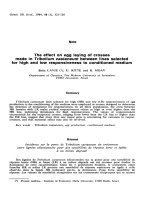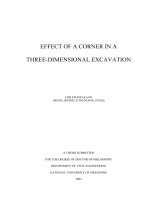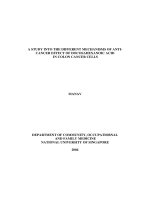Study on the effect of Calcium-alginate and whey protein on the survival rate of Bifidobacterium bifidum in Mayonnaise
Bạn đang xem bản rút gọn của tài liệu. Xem và tải ngay bản đầy đủ của tài liệu tại đây (810.82 KB, 9 trang )
Vietnam Journal of Science and Technology 57 (3B) (2019) 33-41
doi:10.15625/2525-2518/57/3B/14090
STUDY ON THE EFFECT OF CALCIUM-ALGINATE AND WHEY
PROTEIN ON THE SURVIVAL RATE OF Bifidobacterium bifidum
IN MAYONNAISE
Lieu My Dong1, *, Hoang Thi Thuy Hang1, Nguyen Thi Truc Quyen1,
Nguyen Thien Luan1, Le Thi Kim Ngan1, Nguyen Thi Ly1,
Nguyen Huyen Nguyet Tran1, Dang Thi Kim Thuy2
1
Faculty of Food Science and Technology, Ho Chi Minh City University of Food Industry,
140 Le Trong Tan, Tay Thanh, Tan Phu, Ho Chi Minh
2
Institute of Tropical Biology, 9/621 Ha Noi highway, Ho Chi Minh City
*
Email:
Received: 3 August 2019; Accepted for publication: 3 November 2019
Abstract. The functional food development by adding probiotic bacteria is getting a lot of
concern. In this study, Bifidobacterium bifidum AS 1.1886 was encapsulated in calcium-alginate
2 % w/v (C sample) or the mix of calcium-alginate 2 % (w/v) and whey protein 1 % (w/v) (CW
sample) or calcium-alginate 2 % (w/v) coated by whey protein 1 % (w/v) (CcW sample) by
extrusion method, and added to mayonnaise product. The pH changes, the survival rate of
probiotic bacteria, and total yeast and mold count during storage, as well as the probiotic
survival in simulated gastric medium, were evaluated. The result showed that the pH changes
were not significantly different in all mayonnaise samples in this test. The viability of the free
probiotic cell was significant decrease by 5.85 log CFU/g compared to 0.26 ÷ 1.14 log CFU/g in
encapsulated cell samples after four weeks of storage. None of the free cells survived after six
weeks of storage. The total yeast and mold count in samples related to the probiotic count, the
viability of probiotic cells higher 6 log CFU/g might be controlling the growth of yeast and mold
in mayonnaise. Whey protein has been shown to significantly improve the survival rate of B.
bifidum and calcium-alginate coated by whey protein, indicating the most effective protection.
Keywords: calcium-alginate, mayonnaise, microencapsulation, probiotic bacteria, whey protein.
Classification numbers: 1.4.4, 1.4.8.
1. INTRODUCTION
The benefits of probiotic bacteria were investigated in a lot of previous studies [1, 2].
Nowadays, the application of probiotic bacteria in food is a trend to experiment. Products
containing viable probiotic bacteria were multiform, not only dairy products such as yogurt, ice
cream [3, 4] but mayonnaise was also interested in the market. Addition of probiotic into
mayonnaise could make a new product that gives the health benefit of the customer. However,
Lieu My Dong, Hoang Thi Thuy Hang, Nguyen Thi Truc Quyen, Nguyen Thien Luan…
storage condition of mayonnaise was causing a remarkable reduction in the survival rate of
probiotics [5]. These probiotic foods only bring health benefits if probiotics must be alive and
maintain over 6 log CFU/ml (CFU/g) until the consumption [2]. Furthermore, gastrointestinal
and bile salt conditions were the agent causing the death of probiotics, which were sensitive in
this environment [6, 7]. Therefore, many studies to enhance the viability of probiotic were
carried out, and encapsulated probiotic can improve the high survival rate of bacteria. In the
encapsulated technique, the matrix materials play an important role for probiotic protection.
Among the matrix materials such as alginate, chitosan, carrageenan etc., alginate is the high
applicability due to convenience, non-toxic, bacteria protection ability compared to free cells
bacteria [8]. However, previous studies indicated that the probiotic viability was not protected
completely by the calcium-alginate capsule, because its porous structure facilitated the
penetration of ion H of the low pH medium into the capsule [9]. The proposed solution
including, combination of calcium-alginate and supplement wall materials such as whey protein,
starch etc. by mixing or coating that would improve significantly the viable probiotic than pure
calcium-alginate [6, 7, 10]. It has indicated that both methods gave high effects on enhancement
of the viable probiotic bacteria in calcium-alginate. However, the study on the protective effect
of these encapsulation ways in mayonnaise was poorly reported. Therefore, in this study,
Bifidobacterium bifidum was microencapsulated in calcium-alginate and whey protein by mixing
and coating by the extrusion method. Preparations supplied in mayonnaise was determined the
change in storage condition concluding pH change, B. bifidum viability, yeast, and molds counts
and the viability of probiotic in simulated gastrointestinal fluid in this study.
2. MATERIALS AND METHODS
2.1. Bacterial strains and encapsulation
Bifidobacterium bifidum AS 1.1886 strain was cultured in 10 ml of MRS (de Man, Rogosa
and Sharpe) broth at 37 °C for 24 h before being transferred to 90 ml of MRS broth and
incubated under the same conditions. Biomass was collected by centrifuging and used for the
next experiments.
Extrusion encapsulation method was carried out by the following steps [8]. Briefly, 10 ml
cell suspension was added into 40 ml sodium alginate 2.5 % w/v (C sample) or the mix of
sodium alginate 2.5 % w/v and whey protein 1.25 % w/v (CW sample). Then the mix was
injected through an aseptic syringe into 50 ml solution CaCl2 0.05 M and incubated for 15
minutes. The encapsulated beads were collected in case of C and CW samples. In case of coating
samples (CcW), a part of C sample then incubated in whey protein 1 % (w/v) by using shaking
incubator (Techlab LSI-3016R) at 150 rpm for 10 min. The encapsulation yield calculated
according to the following formula:
( )
The particles were measured average size by electrical caliper and storage at 4 oC.
2.2. Mayonnaise preparation
Mayonnaise was carried out according to a previous description [11]. Briefly, soybean oil
(Simply) 74 %, egg 14 %, vinegar (Maille) 10 %, salt (Xuan Hong) 1 %, sugar (Bien Hoa) 1 %,
and white pepper (Xuan Hong) 0.2 %. Sugar and vinegar mingled, and then all other ingredients
34
Study on the effect of calcium-alginate and whey protein on the survival rate…
were added and stirred homogeneously (Digital Ultra-Turrax T25, at 2.000 rpm/1 min). The oil
was added very slowly while stirring continuously (5.000 rpm/5 min). Finally, encapsulated
probiotic or free probiotic cells were added into mayonnaise and storage at 4 oC.
The pH changing of mayonnaise samples and the survival rate of B. bifidum during storage
were determined after storing immediately as well as the end of every two weeks until ten weeks
of storage at 4 oC. The total number of yeast - mold spores were quantified according to ISO
21527-1: 2008. Briefly, the sample was diluted in saline water and then spread on DRBC
(Dichloran Rose Bengal Chloramphenicol) medium at 30 °C ± 1 °C for five days.
2.3. Effects of simulated gastric fluid (SGF) and intestinal fluid (SIF) on B. bifidum after 8
weeks of storage
The experiments were carried out according to the method described by Lieu et al. [11]
with slight modifies. Briefly, 5-grams of the mayonnaise after eight weeks of storage were
incubated in 45 ml of Simulated gastric fluid (SGF) medium (9 g/l NaCl + 3 g/l pepsin
(Himedia) adjusted to pH 2 with 5N HCl), at 37 °C and shaking speed 100 rpm for 120 minutes.
Similarly, 5-grams of mayonnaise were incubated in 45 ml of (simulated intestinal fluid) SIF
medium (0.85 % NaCl, 0.3 % bile salts, adjusted to pH 6.5 with 5N NaOH) at 37 °C for 240
minutes. The viability of B. bifidum in the mayonnaise was immediately assayed by plating on
MRS media.
2.4. Enumeration of free and encapsulated probiotics
The viability of B. bifidum was carried out according to Sultana et al. [6] with slight
modifications. 5-grams were resuspended in 45 mL of phosphate buffer (0.1 M, pH 7.0),
followed by homogenizing in a stomacher (IUL-Spain) for 10 min. The probiotic viability
(CFU/mL) was determined by spreading on MRS-agar at 37 oC for 48 h. The process of similar
samples was used for free samples.
2.5. Statistical analysis
All data obtained will be expressed as ± mean value (SD) of at least three replicates for
each treatment using a Turkey test (SPSS20, IBM Inc.) and on Excel 2013 (Microsoft Inc.).
3. RESULTS AND DISCUSSION
3.1. Encapsulation efficiency
The effect of the microencapsulation method on encapsulation efficiency (EE) is shown in
Figure 1. The results indicated the encapsulation efficiency of all surveyed samples was over
94 %, wherein the highest yield was 97 % microencapsulated probiotic of C, whereas CW and
CcW samples were 96 % and 94.5 %, respectively. However, this difference was not significant
(p > 0.05).
The encapsulation efficiency was an important parameter to evaluate the effect of the
encapsulated process [10]. The higher encapsulation yield decreased the content of preparations
supplying foods leading to reduce the sensory affecting by encapsulated bead. The extrusion
method was prevalent research due to the facility, low fee, and lightly process condition and
35
Lieu My Dong, Hoang Thi Thuy Hang, Nguyen Thi Truc Quyen, Nguyen Thien Luan…
friendly with probiotic [8]. The viability of probiotics in microcapsules increased with an
increase in gel concentration [12]. Besides, the adding of material walls such as resistant starch
(2 % w/v) in calcium-alginate gel could improve encapsulation efficiency [6]. In the present
study, the compound of material walls with alginate (2.5 % w/v) with or without whey protein
(1.25 % w/v) gave a high encapsulation efficiency compared to other material walls (data not
shown). The results in this study also showed that coating with whey protein had the lowest
efficiency of others (Figure 1). A similar result was reported by Ji et al. [10], the EE of B.
longum in calcium-alginate coating by chitosan was 90 ± 3.4 % compared with 95 ± 2.5 % that
of B. longum in pure calcium-alginate. This difference might be due to shaking incubation
process in whey protein for making the coating layer would leak B. bifidum cell from the
Ca-alginate matrix leading to decrease of the encapsulation yield (Figure 1).
C
100
CW
CcW
EE (%)
95
90
85
80
75
70
C
CW
CcW
Figure 1. Encapsulation efficiency (C: alginate; CW: alginate + whey; CcW: whey coating alginate).
3.2. pH changes during storage of mayonnaise
4.25
pH
4.15
4.05
3.95
3.85
0
2
4
6
8
10
Time (week)
C
CW
CcW
Free cells
Control
Figure 2. pH changes in mayonnaise during storage condition
(C: alginate; CW: alginate + whey; CcW: whey coating alginate).
36
Study on the effect of calcium-alginate and whey protein on the survival rate…
The results from Figure 2 show that the pH values of samples have a slight decrease during
the 10-weeks of storage. In general, the pH values of all probiotic supplemented samples tended
to decrease to be lower than that of the non-supplemental control sample, in which the
mayonnaise supplement with a free probiotic showed the lowest pH value.
The change in pH value during storage would affect the product's sensory. Fahimdanesh et
al. [13] reported that the pH value of the probiotic added mayonnaise and control samples was
not different during storage time. Whereas, the study of Khalil et al. [5] indicated that the pH
value of the mayonnaise containing encapsulated bead was lower than the control sample.
However, the result from this study (Figure 2) agrees with the study of Ding et al. [14] that the
pH value of the control sample was higher than that of the probiotic supplement sample. During
storage, free probiotic bacterial cells can still use carbohydrates and produce small amounts of
acid, which causes the product pH to be decreased gradually during storage [14]. Meanwhile,
the uptake of nutrients and metabolic release processes take place more slowly through the
microscopic shell of alginate [6] that leading to the pH value of the encapsulated and control
samples was slightly higher than that of free probiotic cell sample (Figure 2).
3.3. Survival of B. bifidum during mayonnaise storage
The effect of storage conditions on the viability of B. bifidum in mayonnaise is shown in
Figure 3. The results showed that free and encapsulated B. bifidum all tend to decrease during
ten weeks of storage at 4 ºC. In the sample containing free cells, the viability of B. bifidum
decreased rapidly with more than 5.8 log CFU lost after 4th weeks of storage and no cells were
recorded after 6th weeks of storage (Figure 3). In samples containing encapsulation cells, the
viability of B. bifidum in C samples decreased sharply to less than 6 log CFU/g while CW and
CcC samples were all higher. At the 10th week of storage, the probiotic density at all three
samples decreased to 4.17 ± 0.12, respectively; 5.15 ± 0.09, and 5.33 ± 0.12 log CFU/g.
9.000
8.000
7.000
log CFU/g
6.000
C
5.000
CW
4.000
3.000
CcW
2.000
Free
cells
1.000
0.000
0
2
4
Time (week)
6
8
10
Figure 3. Survival of free and microencapsulated cells in mayonnaise during storage condition (C:
alginate; CW: alginate + whey; CcW: whey coating alginate).
37
Lieu My Dong, Hoang Thi Thuy Hang, Nguyen Thi Truc Quyen, Nguyen Thien Luan…
The study also showed that CcW samples maintained a stable amount of B. bifidum during
the first 4-weeks of storage (Figure 3).
Storage conditions in which low pH value products are agents that significantly affect the
viability of probiotic bacteria. Besides, the activity of probiotic bacteria still occurs under
storage conditions [3], produce acid, and result in pH reduction. These effects are responsible for
the decreased sharply in B. bifidum density during storage (Figure 3). In previous studies,
calcium-alginate showed a higher ability to protect Bifidobacteria in mayonnaise than in free
cells. Microcapsules structure helps to limit the impact of the environment inside of the
composition [10]. The results from Figure 3 showed that calcium-alginate improved B. bifidum
survival rate compared to control, and the protective effect was significantly improved when
combined with whey protein (Figure 3). The porous structure in the calcium-alginate gel
network facilitates inhibitors to enter and cause cell death [9]. High buffering whey protein [15],
when combined with calcium-alginate, may help to limit the porous structure of the composition,
which improves the B.bifidum survival rate (Figure 3). Besides, the concentration of B. bifidum
in stable CcW samples during the first weeks of storage showed that calcium-alginate coated by
whey protein had a better protective effect than the mixed form. The results also show that the 8week storage period is suitable to ensure the requirement of probiotic food [2].
3.4. The growth of yeast and molds during mayonnaise storage
The growth of yeast and molds during 10 weeks of mayonnaise storage was presented in
Table 1. These results showed that total yeast and molds counts in a sauce containing free cells
were not discovered after 4 weeks, however, the presence of total yeast and molds was recorded
after 6 weeks storage. In tenth weeks, the growth of yeast and molds in mayonnaise adding
microencapsulated probiotics was remarked (Table 1)
Table 1. The growth of yeast and molds (log CFU/g) in mayonnaise sauce at 4 °C.
Week
0
2
4
6
8
10
C sample
Na
Na
Na
Na
Na
2.22 ± 0.18
CW sample
Na
Na
Na
Na
Na
2.14 ± 0.16
CcW sample
Na
Na
Na
Na
Na
2.17 ± 0.10
Free cells
Na
Na
Na
2.14 ± 0.11
2.81 ± 0.14
3.16 ± 0.16
Control
Na
Na
Na
2.25 ± 0.18
2.67 ± 0.22
3.54 ± 0.19
Na: Not noticed when the density is below 2 logs CFU/g.
Evaluation of yeast and molds growth was to determine the contamination level of food
products and control harmful bacteria, which last the shelf life of products. Probiotic bacteria not
only contribute health benefits for the consumer but also be an antibacterial agent due to the
production of bacteriocin [16]. The results showed that total yeast-mold was recorded in samples
containing free probiotic cells at 6th-week when B. Bifidum was not recorded in these
mayonnaise samples (Table 1). The same result for encapsulated B. bifidum samples that the
total yeast and molds only detected in 10th weeks of storage when the viability of B. bifidum
decreased drastically compared to the initial density (Table 1). A similar result was reported by
Khalil et al. [5], that the probiotic bacteria significantly affected the growth of the total yeast and
molds in mayonnaise. This result showed that the viability of probiotic cells higher 6 log CFU/g
would be controlling the growth of yeast and molds in products (Figure 3, Table 1). This finding
38
Study on the effect of calcium-alginate and whey protein on the survival rate…
also investigated that 8-weeks storage was suitable for ensuring the number of probiotic bacteria
in products [2] and controlling yeast and molds growth in products (Figure 3, Table 1).
3.5. The viability of B. bifidum in SGF and SIF after 8 weeks of storage
The survival of B. bifidum in SGF and SIF after 08 weeks of storage is shown in Figure 4.
The result showed that there was a significant difference among these samples, in which the
viability of B. bifidum in C samples was the lowest (p < 0.05) in the study. Whey protein has
been shown to significantly improve the survival rate of B. bifidum and calcium-alginate coated
by whey protein, indicating the most effective protection (Figure 4). The condition of digestive
fluids is a lethal agent for probiotic bacteria [10]. Calcium-alginate beads significantly improve
the viability of probiotic bacteria [5]. However, at pH conditions below 4, the calcium-alginate
structure network is easily converted into the soluble alginic acid form [17], leading to B.
bifidum, the bacterium that was unable to grow under pH below 4 [18], in the capsules rapidly
exposed to pH and cell death conditions (Figure 4). Whey protein with high buffering properties
has shown to significantly improve the probiotic microbial viability compared to nonsupplemental samples (Figure 4). Restricting the porous structure of calcium-alginate with the
addition of other microcapsules published in previous studies has shown to significantly improve
the viability of probiotic bacteria [6, 7]. Rajam et al. [7] demonstrated that the combination of
whey protein and sodium alginate significantly improves the viability of probiotic bacteria in
simulated gastrointestinal conditions. However, studies on the protection effectiveness of
capsules in mixed and coating ways were poorly reported. The present study showed that
capsules with whey protein as the coating layer that shows greater efficacy than mixed forms
(Figures 3, 4). This would be because when whey protein added during calcium-alginate
microcapsule production has affected the gel structure network. Whereas, the gel structure
network was not affected by the whey protein coating process.
Density reduction of probiotic in SGF
and SIF (%)
120
Al + W mix
90
b
b
Al
Al + W coating
a
a
b
60
c
30
0
BD
SIF
SGF
Figure 4. Survey of probiotic density in SFG and SIF.
4. CONCLUSIONS
The results of this study indicated that the encapsulation way (mix or coat) did not affect
considerably on the encapsulation efficiency of the extrusion method. The storage condition of
mayonnaise affected significantly on the survival of B. bifidum meanwhile encapsulation
technique would improve the viability of this probiotic bacteria. Besides, the pH value of free
39
Lieu My Dong, Hoang Thi Thuy Hang, Nguyen Thi Truc Quyen, Nguyen Thien Luan…
cell samples had a trend to decrease lower than that of encapsulated and control samples.
Moreover, the development of yeast-molds was related to the density of probiotic in
mayonnaise. This result showed that the viability of B. bifidum higher 6 log CFU/g would be
controlling the growth of yeast and molds in mayonnaise. The supplement of whey protein into
calcium-alginate encapsulation improved significantly the survival of B. bifidum cells during
storage time and in the simulated gastrointestinal conditions. Whey protein coating calciumalginate identified the best B. bifidum protection efficiency compared to others. The results of
this study indicated a potential applicability of encapsulated probiotic cells in mayonnaise
product.
REFERENCES
1.
Rafter J. - Lactic acid bacteria and cancer: mechanistic perspective, British Journal of
Nutrition 88 (S1) (2002) S89-S94.
2.
Agrawal R. - Probiotics: An emerging food supplement with health benefits, Food
Biotechnology 19 (3) (2005) 227–246.
3.
Kailasapathy K. - Survival of free and encapsulated probiotic bacteria and their effect on
the sensory properties of yogurt, LWT-Food Science and Technology 39 (10) (2006)
1221-1227.
4.
de Farias T. G. S., Ladislau H. F. L., Stamford T. C. M., Medeiros J. A. C., Soares B. L.
M., Arnaud T. M. S., and Stamford T. L. M. - Viabilities of Lactobacillus rhamnosus
ASCC 290 and Lactobacillus casei ATCC 334 (in free form or encapsulated with calcium
alginate-chitosan) in yellow mombin ice cream, LWT 100 (2019) 391-396.
5.
Khalil A. H., and Mansour E. H. - Alginate encapsulated bifidobacteria survival in
mayonnaise, Journal of Food Science 63 (4) (1998) 702-705.
6.
Sultana K., Godward G. , Reynolds N., Arumugaswamy R., Peiris P. and Kailasapathy K.
-Encapsulation of probiotic bacteria with alginate–starch and evaluation of survival in
simulated gastrointestinal conditions and in yogurt. International journal of food
microbiology 62 (1-2) (2000) 47-55.
7.
Rajam R., Karthik P., Parthasarathi S., Joseph G. and Anandharamakrishnan C. - Effect of
whey protein–alginate wall systems on the survival of microencapsulated Lactobacillus
Plantarum in simulated gastrointestinal conditions. Journal of Functional Foods 4 (4)
(2012) 891-898.
8.
Krasaekoopt W., Bhandari B., and Deeth H. - Evaluation of encapsulation techniques of
probiotics for yogurt, International Dairy Journal 13 (1) (2003) 3-13.
9.
Dehkordi S. S., Alemzadeh I., Vaziri A. S., and Vossoughi A. - Optimization of AlginateWhey Protein Isolate Microcapsules for Survivability and Release Behavior of Probiotic
Bacteria, Applied Biochemistry and Biotechnology 7 (2019) 1-15.
10. Ji R., Wu J., Zhang J., Wang T., Zhang X., Shao L., Wang J. - Extending Viability of
Bifidobacterium longum in Chitosan-Coated Alginate Microcapsules Using
Emulsification and Internal Gelation Encapsulation Technology, Frontiers in
Microbiology 10 (2019) 1-10
11. Lieu M. D., Dang T. K. T., and Nguyen T. H. - Viability of microencapsulated
Lactobacillus casei in synbiotic mayonnaise, Food Res. 1 (6) (2017) 234-239.
40
Study on the effect of calcium-alginate and whey protein on the survival rate…
12. Chandramouli V., Kasipathy K., Paul P., and Mark J. - An improved method of
microencapsulation and its evaluation to protect Lactobacillus spp. in simulated gastric
conditions, Journal of microbiological methods 56 (1) (2004) 27-35.
13. Fahimdanesh M., Mohammadi N., Ahari H., Zanjani M. K., Hargalani F. Z., and
Behrouznasab K. - Effect of microencapsulation plus resistant starch on survival of
Lactobacillus casei and Bifidobacterium bifidum in mayonnaise sauce, African Journal of
Microbiology Research 6 (40) (2012) 6853-6858.
14. Ding W. K. and Shah N. P. - Survival of Free and Microencapsulated Probiotic Bacteria
in Orange and Apple Juices. International Food Research Journal 15 (2) (2008) 219-232.
15. Akalın A. S., Fenderya S., and Akbulut N. - Viability, and activity of Bifidobacteria in
yogurt containing fructooligosaccharide during refrigerated storage, International journal
of food science & technology 39 (6) (2004) 613-621.
16. Rodgers S. - Novel applications of live bacteria in food services: probiotics and protective
cultures, Trends in Food Science & Technology 19 (4) (2008) 188-197.
17. Pasparakis G. and Bouropoulos N. - Swelling studies and in vitro release of verapamil
from calcium alginate and calcium alginate–chitosan beads, International Journal of
Pharmaceutics 323 (1-2) (2006) 34-42.
18. Lourens-Hattingh A. and Viljoen B. C. - Yogurt as probiotic carrier food, International
dairy Journal 11 (1-2) (2002) 1-17.
41

